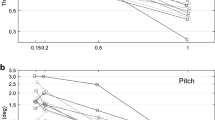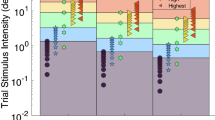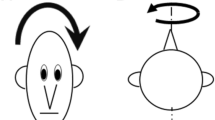Abstract
We describe in detail the frequency response of the human three-dimensional angular vestibulo-ocular response (3-D aVOR) over a frequency range of 0.05–1 Hz. Gain and phase of the human aVOR were determined for passive head rotations in the dark, with the rotation axis either aligned with or perpendicular to the direction of gravity (earth-vertical or earth-horizontal). In the latter case, the oscillations dynamically stimulated both the otolith organs and the semi-circular canals. We conducted experiments in pitch and yaw, and compared the results with previously-published roll data. Regardless of the axis of rotation and the orientation of the subject, the gain in aVOR increased with frequency to about 0.3 Hz, and was approximately constant from 0.3 to 1 Hz. The aVOR gain during pitch and yaw rotations was larger than during roll rotations. Otolith and canal cues combined differently depending upon the axis of rotation: for torsional and pitch rotations, aVOR gain was higher with otolith input; for yaw rotations the aVOR was not affected by otolith stimulation. There was a phase lead in all three dimensions for frequencies below 0.3 Hz when only the canals were stimulated. For roll and pitch rotations this phase lead vanished with dynamic otolith stimulation. In contrast, the horizontal phase showed no improvement with additional otolith input during yaw rotations. The lack of a significant otolith contribution to the yaw aVOR was observed when subjects were supine, prone or lying on their sides. Our results confirm studies with less-natural stimuli (off-vertical axis rotation) that the otoliths contribute a head-rotation signal to the aVOR. However, the magnitude of the contribution depends on the axis of rotation, with the gain in otolith-canal cross-coupling being smallest for yaw axis rotations. This could be because, in humans, typical yaw head movements will stimulate the otoliths to a much lesser extent then typical pitch and roll head movements.





Similar content being viewed by others
Notes
We adopt the sign conventions for horizontal and vertical eye movements that are traditionally used in studies of 2-D eye movements. By deviating from the “right hand rule”, we are not forced, for example, to represent a downward eye movement as an upward deflection on a graph.
References
Angelaki DE, Hess BJ (1995) Inertial representation of angular motion in the vestibular system of rhesus monkeys. II. Otolith-controlled transformation that depends on an intact cerebellar nodulus. J Neurophysiol 73:1729–1751
Angelaki DE, Hess BJ (1996) Three-dimensional organization of otolith-ocular reflexes in rhesus monkeys. II. Inertial detection of angular velocity. J Neurophysiol 75:2425–2440
Angelaki DE, McHenry MQ, Dickman JD, Newlands SD, Hess BJM (1999) Computation of inertial motion: neural strategies to resolve ambiguous otolith information. J Neurosci 19:316–327
Angelaki DE, Newlands SD, Dickman JD (2002) Inactivation of semicircular canals causes adaptive increases in otolith-driven tilt responses. J Neurophysiol 87:1635–1640
Aw ST, Haslwanter T, Halmagyi GM, Curthoys IS, Yavor RA, Todd MJ (1996) Three-dimensional vector analysis of the human vestibuloocular reflex in response to high-acceleration head rotations I. Responses in normal subjects. J Neurophysiol 76:4009–4020
Baloh RW, Demer J (1991) Gravity and the vertical vestibulo-ocular reflex. Exp Brain Res 83:427–433
Barmack NH, Pettorossi VE (1988) The otolithic origin of the vertical vestibuloocular reflex following bilateral blockage of the vertical semicircular canals in the rabbit. J Neurosci 8:2827–2835
Blanks RH, Anderson JH, Precht W (1978) Response characteristics of semicircular canal and otolith systems in cat. II. Responses of trochlear motoneurons. Exp Brain Res 32:509–528
Bockisch CJ, Straumann D, Haslwanter T (2003) Eye movements during multiaxis whole-body rotations. J Neurophysiol 89:355–366
Clarke AH, Grigull J, Mueller R, Scherer H (2000) The three-dimensional vestibulo-ocular reflex during prolonged microgravity. Exp Brain Res 134:322–334
Crane BT, Viirre ES, Demer JL (1997) The human horizontal vestibulo-ocular reflex during combined linear and angular acceleration. Exp Brain Res 114:304–320
Crane BT, Tian JR, Demer JL (2000) Initial vestibulo-ocular reflex during transient angular and linear acceleration in human cerebellar dysfunction. Exp Brain Res 130:486–496
Dai MJ, Curthoys IS, Halmagyi GM (1989) A model of otolith stimulation. Biol Cybern 60:185–194
Darlot C, Denise P, Droulez J, Cohen B, Berthoz A (1988) Eye movements induced by off-vertical axis rotation (OVAR) at small angles of tilt. Exp Brain Res 73:91–105
Demer JL, Oas JG, Baloh RW (1993) Visual-vestibular interaction in humans during active and passive, vertical head movement. J Vestibul Res 3:101–114
Fernandez C, Goldberg JM (1971) Physiology of peripheral neurons innervating semicircular canals of the squirrel monkey. II. Response to sinusoidal stimulation and dynamics of peripheral vestibular system. J Neurophysiol 34:661–675
Fetter M, Heimberger J, Black RA, Hermann W, Sievering F, Dichgans J (1996) Otolith-semicircular canal interaction during postrotatory nystagmus in humans. Exp Brain Res 108:463–472
Furman JM, Schor RH, Schumann TL (1992) Off-vertical axis rotation: a test of the otolith-ocular reflex. Ann Oto Rhinol Laryn 101:643–650
Glasauer S, Mittelstaedt H (1998) Perception of spatial orientation in microgravity. Brain Res Brain Res Rev 28:185–193
Groen E, Bos JE, De Graaf B (1999) Contribution of the otoliths to the human torsional vestibulo-ocular reflex. J Vestibul Res 9:27–36
Harris LR, Barnes GR (1987) Orientation of vestibular nystagmus is modified by head tilt. In: Graham MD, Kemink JL (eds) The vestibular system: Neurophysiologic and clinical research. Raven, New York, pp 539–548
Haslwanter T, Jaeger R, Mayr S, Fetter M (2000) Three-dimensional eye-movement responses to off-vertical axis rotations in humans. Exp Brain Res 134:96–106
Hepp K (1990) On Listing’s law. Commun Math Phys 132:285–292
Hyden D, Larsby B (1991) Velocity dependence of the vestibulo-ocular reflex over a broad frequency range. Acta Otolaryngol Suppl 481:293–294
Jaeger R, Takagi A, Haslwanter T (2002) Modeling the relation between head orientations and otolith responses in humans. Hearing Res 173:29–42
Kasteel-van Linge A, Maas AJ (1990) Quantification of visuo-vestibular interaction up to 5.0 Hz in normal subjects. Acta Otolaryngol 110:18–24
Kleinbaum DG, Kupper LL, Muller KE (1988) Applied regression analysis and other multivariable methods. PWS-Kent, Boston, MA
Lansberg MP, Guedry J, Graybiel A (1965) Effect of changing resultant linear acceleration relative to the subject on nystagmus generated by angular acceleration. Aerosp Med 456–460
Mardia KV (1972) Statistics of directional data. Academic, New York
Mathog RH (1972) Testing of the vestibular system by sinusoidal angular acceleration. Acta Otolaryngol 74:96–103
Mayne R (1974) A systems concept of the vestibular organs. In: Kornhuber HH (ed) Handbook of sensory physiology. Springer, Berlin Heidelberg New York, pp 493–580
Merfeld DM, Young LR (1995) The vestibulo-ocular reflex of the squirrel monkey during eccentric rotation and roll tilt. Exp Brain Res 106:111–122
Merfeld D, Young LR, Oman CM, Shelhamer M (1993) A multidimensional model of the effect of gravity on the spatial orientation of the monkey. J Vestibul Res 3:141–161
Merfeld DM, Zupan LH, Gifford CA (2001) Neural processing of gravito-inertial cues in humans. II. Influence of the semicircular canals during eccentric rotation. J Neurophysiol 85:1648–1660
Minor LB, Lasker DM, Backous DD, Hullar TE (1999) Horizontal vestibuloocular reflex evoked by high-acceleration rotations in the squirrel monkey. I. Normal responses. J Neurophysiol 82:1254–1270
Mittelstaedt H (1983) A new solution to the problem of the subjective vertical. Naturwissenschaften 70:272–281
Mittelstaedt H, Glasauer S (1993) Crucial effects of weightlessness on human orientation. J Vestibul Res 3:307–314
Mok D, Ro A, Cadera W, Crawford DJ, Vilis T (1992) Rotation of Listing’s Plane during vergence. Vision Res 32:2055–2064
Paige GD, Tomko DL (1991) Eye movement responses to linear head motion in the squirrel monkey. I. Basic characteristics. J Neurophysiol 65:1170–1182
Peterka RJ (1992) Response characteristics of the human torsional vestibulo-ocular reflex. Ann NY Acad Sci 656:877–879
Peterka RJ, Black FO, Schoenhoff MB (1990) Age-related changes in human vestibulo-ocular reflexes: Sinusoidal rotation and caloric tests. J Vestibul Res 1:49–59
Pettorossi VE, Errico P, Santarelli RM (1991) Contribution of the maculo-ocular reflex to gaze stability in the rabbit. Exp Brain Res 83:366–374
Rude SA, Baker JF (1988) Dynamic otolith stimulation improves the low frequency horizontal vestibulo-ocular reflex. Exp Brain Res 73:357–363
Sato H, Sando I, Takahashi H (1992) Computer-aided three-dimensional measurement of the human vestibular apparatus. Otolaryng Head Neck 107:405–409
Schmid-Priscoveanu A, Straumann D, Kori A (2000) Torsional vestibulo-ocular reflex during whole-body oscillation in the upright and the supine position: I. Responses in healthy human subjects. Exp Brain Res 134:212–219
Smith ST, Curthoys IS, Moore ST (1995) The human ocular torsion position response during yaw angular acceleration. Vision Res 35:2045–2055
Takagi A, Sando I (1988) Computer-aided three-dimensional reconstruction and measurement of the vestibular end-organs. Otolaryng Head Neck 98:195–202
Tomko DL, Wall C III, Robinson FR, Staab JP (1988) Influence of gravity on cat vertical vestibulo-ocular reflex. Exp Brain Res 69:307–314
Tweed D, Cadera W, Vilis T (1990) Computing three-dimensional eye position quaternions and eye velocity from search coil signals. Vision Res 30:97–110
Tweed D, Sievering D, Misslisch H, Fetter M, Zee D, Koenig E (1994) Rotational kinematics of the human vestibuloocular reflex I. Gain matrices. J Neurophysiol 72:2467–2479
Zhang X, Zakir M, Meng H, Sato H, Uchino Y (2001) Convergence of the horizontal semicircular canal and otolith afferents on cat single vestibular neurons. Exp Brain Res 140:1–11
Zhang X, Sasaki M, Sato H, Meng H, Bai RS, Imagawa M, Uchino Y (2002) Convergence of the anterior semicircular canal and otolith afferents on cat single vestibular neurons. Exp Brain Res 147:407–417
Zupan LH, Peterka RJ, Merfeld DM (2000) Neural processing of gravito-inertial cues in humans. I. Influence of the semicircular canals following post-rotatory tilt. J Neurophysiol 84:2001–2015
Zupan LH, Merfeld DM, Darlot C (2002) Using sensory weighting to model the influence of canal, otolith and visual cues on spatial orientation and eye movements. Biol Cybern 86:209–230
Acknowledgements
We thank B.J.M. Hess for valuable discussions about the data; A. Schmid-Priscoveanu and A.A. Kori for the use of their data; A. Züger for technical assistance, and T. Schmückle and K. Weber for assistance when conducting the experiments. Supported by the Swiss National Science Foundation [3100–063669 (T.H.); 32–51938.97 SCORE A (D.S.) / 31–63465.00 (D.S.)]; Olga-Mayenfisch Foundation, Hartmann-Mueller Foundation, and the Betty and David Koetser Foundation for Brain Research, Zürich, Switzerland.
Author information
Authors and Affiliations
Corresponding author
Rights and permissions
About this article
Cite this article
Bockisch, C.J., Straumann, D. & Haslwanter, T. Human 3-D aVOR with and without otolith stimulation. Exp Brain Res 161, 358–367 (2005). https://doi.org/10.1007/s00221-004-2080-1
Received:
Accepted:
Published:
Issue Date:
DOI: https://doi.org/10.1007/s00221-004-2080-1




